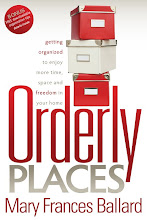Photo courtesy of hgtv.com
With the holiday season approaching, this month we will
concentrate on organizing the
kitchen
and pantry.
At the end of this
article are a few other tips to consider in November.
Hopefully these will make planning and staying
organized easier.
Maintain a current inventory of food supplies. Check the pantry often to be sure you do not
get caught short as grocery store shelves get depleted quickly. I have already purchased my frozen pumpkin
pies and Pillsbury All Ready Pie Crust.
(Please don’t cringe; my family doesn’t know the difference!)
- Arrange food items, cookware and utensils used in
food preparation as close to the range and refrigerator as possible.
- Remove items from one cabinet at a time and sort.
- Dispose of any expired food products, broken
appliances, containers without lids, lids without containers and excess
margarine tubs, grocery bags, etc. that you may have collected.
- Place any food products, cookware, appliances or
utensils you do not use in a donate or sell container.
- Clean the cabinet and place a shelf liner that can be
wiped clean on the shelf.
- Place similar types of food items together.
- Canned foods can be placed on stair step shelves that
can adjust to the width of the cabinet, in gravity feed containers like
those used for soda cans or on pull out shelves or racks.
- Spices can be stored on smaller stair step shelves in
cabinets or drawers or on turntables.
- Unless you use them quickly, boxes of cereals,
pastas, rice and other dry goods that have been opened should have the
contents moved to air tight containers.
Clear plastic containers or recycled clear glass food containers
with labels are good choices.
- Use a standard size of food container for
leftovers. The lids should fit the
shallow and deeper containers to make organizing easier. Square and rectangular containers use
space more efficiently and clear containers make identification easier.
- Free standing wire shelves, under the shelf wire
baskets, pull out wire baskets or shelves and turntables are all options
to add more storage space in the cabinets.
- Drawer dividers should be used to contain utensils,
knives and other small items.
- Potholders should be kept near the range in a drawer
or container on the counter.
- Hanging racks with hooks from the ceiling or placing
a towel rod or dowel with hooks on the wall under cabinets can be used for
pots and pans or large utensils.
- Magnetic tool strips can be mounted on the wall for
knives and other metal utensils.
- Racks and hooks can be placed inside cabinet doors to
hold smaller items.
- Pull out shelves and/or wire baskets are essential
for storing items in the back of lower base cabinets. It is very difficult to reach items so
near the floor and so far inside the cabinet.
- Store small packets of drink mix or sauce and
seasoning mixes together in small square containers on the shelf.
- Wire racks designed to hold pan lids can be used in
deep cabinets to store cookie sheets and baking pans vertically rather
than stacking them. Cabinets over
built in ovens are an ideal placement for these. Permanent vertical dividers are also a
good idea for that space.
- Pot lids can be hung inside some cabinet doors on
specialty racks or behind a towel bar mounted so the handle at the top of
the lid catches on the rod.
- Label shelves inside cabinets so that other family
members will return items to their home.
- If your pantry or refrigerator has wire shelves,
consider purchasing acrylic or plastic shelf covers. Measure for a good
fit.
- The refrigerator should have similar items grouped
together.
- Use the designated bins in refrigerators for those
items. They are designed to
maintain the correct temperature and humidity for those items.
- Add turntables, free standing wire shelves and other
space saving items to the refrigerator to keep items organized.
- The door is the warmest part of the
refrigerator. Do not store eggs,
milk or meats in it for food safety reasons.
- Cookbooks should be stored near this zone, but should
be purged so that they do not take up valuable space. Try not to store any on the
counters.
- Cookbooks you do not use can be donated or sold. If you must keep those, consider
displaying them on the hidden spaces at the tops of counters or on shelves
over doors or windows in the kitchen.
- Keep an attractive container with pens, pencils, note
pad and scissors in a convenient location in case they are needed.
More November Tips
If you send holiday cards, buy, address and get them ready
to mail. The earlier you purchase them,
the better the selection. Consider creating an attractive e-mail card
wherever possible and save the environment, time and money. You can even include pictures, etc. If the
recipients love paper cards, they can print it.
If you choose to send a holiday newsletter, remember to keep
it short and sweet. The shorter, the
sweeter. No bragging is allowed; keep it
newsy with love and appreciation for the input the recipients have had in your
lives.
Have packages for mailing out of town ready to send. Some overseas deadlines occur in November.
Now is the best time for online shopping. Almost all stores are offering free shipping
and the selection is better now than later.
Send out “save the date” or invitations for holiday
gatherings. The earlier the better as
this is a busy time of year for everyone.
If you use a paper planner, purchase one now. The selection is better and you can begin
putting important dates for next year in it.
I recommend a planner that shows a week at a glance with the days
divided vertically into hours.
There are several good tips to keep Thanksgiving Week an
orderly and peaceful event.
1) Use
a schedule to plan the activities for the week.
Work backwards from the time of the big event (Thanksgiving Dinner is
usually it). Be flexible with the amount
of time you allow for meal preparation, decorations, clean up, etc. You should do as much ahead of the big day as
possible.
2)
Do not leave home for Black Friday sales unless you are prepared. Use whatever media you have to decide where
you should go, when you should get there and what you will buy. Make a
list and stick to it. Being
surrounded by great deals on so many items will tempt you to buy items you
really don’t need but hate to pass up because they are such a great deal. This can be a great budget buster as well as
a clutter creator. Retailers are
counting on luring you in with the super sale only to have you lured into the
other wonderful items not on your list.
Consider staying home for a
peaceful end to the week and shop online if you must make purchases. Many outlets have the same sales online with
free shipping this time of the year.
With no parking problems, traffic jams or lines at checkout, you can
have even more reasons to be thankful.

